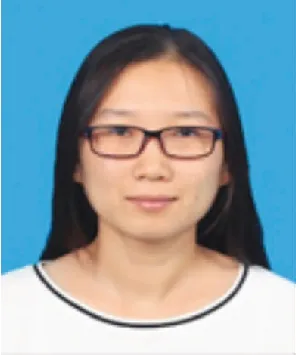Study on Spectra of Eu 4f76p3/2ns Autoionizing States
2017-12-05,,-,-*
, , -, -*
(1. School of Science, Tianjin University of Technology, Tianjin 300384, China;2. Key Laboratory of Display Materials and Photoelectric Devices, Ministry of Education, Tianjin University of Technology, Tianjin 300384, China)
StudyonSpectraofEu4f76p3/2nsAutoionizingStates
WANGJing1,2,SHENLi1,2,YANGYu-na1,2,DAIChang-jian1,2*
(1.SchoolofScience,TianjinUniversityofTechnology,Tianjin300384,China;2.KeyLaboratoryofDisplayMaterialsandPhotoelectricDevices,MinistryofEducation,TianjinUniversityofTechnology,Tianjin300384,China)

Eu atom;4f76p3/2ns autoionizing states; spectra; isolated-core excitation; laser polarization
1 Introduction
The influences of laser polarization on the spectra of high-lying states of the alkaline-earth atoms, have been observed in the earlier studies[11-12]. Among the rare-earth atoms, Yb atom has been studied most[13]due to the fact that it has ground state withJ0=0 and a full-filled 4f shell. Eu atom, however, with a half-filled 4f shell and the ground state withJ0=7/2, is expected to have a much more complicated spectrum, leading to a more challenging situation. Therefore, it is necessary to study autoionization spectra of Eu atom with different laser polarization combinations of the three lasers.
Based on the physical significance and the research status mentioned above, it is apparent that the study of Eu 4f76p3/2nlautoionizing states is very necessary. In this work, Eu 4f76p3/2ns (n=7, 8) autoionizing states are investigated with the ICE technique[8-9]for the first time, which are studied with different laser polarization combinations.
2 Experiments
The experimental setup for present work is shown in Fig.1, which consists of three parts: a laser system, an Eu atomic beam preparation system and a data acquisition system.

Fig.1 Experimental setup contains a laser system, an atomic beam system and a data acquisition system, where the letter P denotes a polarization controller.
The laser system contains three tunable dye lasers with a line width of 0.2 cm-1and pulse energy of 0.5 mJ, which are used for the three-step excitation. The three tunable dye lasers are pumped by the 2nd-harmonic or 3rd-harmonic generation (at wavelength of 532 nm or 355 nm) of the same Nd∶YAG pulse laser. Nd∶YAG pulse laser has a repetition rate of 20 Hz and pulse width of 5-8 ns.

The data acquisition system, including a Boxcar and a digital pulse generator, is controlled by a computer. The ions, resulting from the excitation and subsequent decay of autoionizing states, are extracted with a pulsed electric field to a micro channel plate (MCP) detector, whose output is fed into the Boxcar and stored in a computer for further analysis.
As mentioned above, this work will investigate the spectra of Eu 4f76p3/2ns (n=7, 8) autoionizing states with the ICE technique. The schemes Ⅰ and Ⅱ are designed for the 4f76p3/2ns (n=7, 8) autoionizing states, respectively, as follows.







Fig.2 Schematic diagram of the Eu 4f76p3/2ns autoionizing states


(1)
whereφi=0, ±1, representing a change ofMi(i=1, 2, 3) by absorbing photons for each excitation, whileqrepresents each possible transition channel.

W(J=3/2)∶W(J=5/2)∶W(J=7/2)=
a∶b∶c,
(2)
wherea,bandcrepresent constants proportional to the reduced matrix elements of the transition.
3 Results and Discussion
As shown in Fig.3, the spectra of Eu 4f76p3/27s autoionizing states are obtained by the scheme Ⅰ, which are fitted the Fano-type line shapes for comparison.



Now let us study theJ3values of the final autoionizing states. At first, the possibleJ3values of the 4f76p3/27s autoionizing states are obtained from Eq. (1) are given in Tab.1, for the cases |ΔM|=0 and |ΔM|=1, respectively. Then, the experimental results for the transition intensities of the the corresponding peaks are given in Tab.2.


CaseNormalizedtransitionintensityJ3=3/2J3=5/2J3=7/2ΔM=0abcΔM=12.5a1.26b1.53c
Since Eu ground state is degenerated, the each possibleJ3value of the 4f76p3/27s autoionizing states is not equal to zero, which is quite different from that of the alkaline-earth atoms[15].


PeaknumberEnergy/cm-1Intensityratio155590.61.76255659.91.22355668.41.15455691.12.38555720.91.65655761.82.02755802.91.48855818.51.46955834.41.85




One may find that the 4f76p3/28s autoionization spectra are superimposed with many narrow peaks, of which the line widths are much smaller. Because the line width of a autoionization peak is inversely proportional to (n*)3that is the effective quantum number, those narrow peaks may be the fingerprints of the 4f76p1/2nlor 4f75dnlautoionizing states. Besides, because of the strong configuration interaction among different autoionization series converging to different ionization limits, the structures of some peaks show very complex.
4 Conclusion
In this work, the spectra of Eu 4f76p3/2ns (n=7, 8) autoionizing states are investigated using the ICE technique through the two laser polarization combinations (πππ, σσσ). The Eu 4f76p3/27s autoionization spectra show the Fano-type profiles while the 4f76p3/28s autoionization spectra exhibit the Lorentzian profiles, indicating that the ICE technique is more valid with the increase of thenvalue. Furthermore, we observe the impact of laser polarization on the Eu 4f76p3/2ns (n=7, 8) autoionization spectra. The corresponding peaks of the 4f76p3/27s autoionizing states have apparent transition intensity, leading that the possibleJ3values can be identified. For the 4f76p3/28s autoionization spectra, we can obtain the energy levels and line widths. In addition, due to the strong configuration interaction among different autoionization series, the structures of the peaks superimposed on Eu 4f76p3/28s autoionization spectra show very complicated.
[1] LYRAS A, BACHAU H. Multiple phase control in Mg through the continuum [J].Phys.Rev. A, 1999, 60(60):4781-4787.
[2] PASPALAKIS E, KYLSTRA N J, KNIGHT P L. Propagation dynamics in an autoionization medium [J].Phys.Rev. A, 1999, 60(1):642-647.
[3] APALATEGUI B, MECKING S, LAMBROPOULOS P. Coherent excitation and manipulation of discrete states embedded in continua [J].LaserPhys., 1999, 9(4):773-787.
[4] YI J H, PARK H M, LEE J M. Investigation of even parity autoionizing states of ytterbium atom by two-photon ionization spectroscopy [J].J.KoreanPhys.Soci., 2001, 39(5):916-920.
[5] BIEMONT E, QUINET P, DAI Z W,etal.. Lifetime measurements and calculations in singly ionized ytterbium [J].J.Phys. B:Atom.Mol.Opt.Phys., 2002, 35(22):4743.
[6] BUSHAW B A, NORTERSHAUSER W, BLAUM Ketal.. Studies of narrow autoionizing resonances in gadolinium [J].SpectrochimicaActaPart B, 2003, 58(6):1083-1095.
[7] QIN W J, DAI C J, XIAO Y,etal.. Investigation of autoionization spectra of Sm using an isolated-core excitation method [J].Chin.Phys. B, 2009, 18(5):1833-1837.
[8] WU X R, SHEN L, ZHANG K,etal.. Branching ratio and angular distribution of ejected electrons from Eu 4f76p1/2nd auto-ionizing states [J].Chin.Phys. B, 2016, 25(9):093203.
[9] ZHANG K, SHEN L, DONG C,etal.. The VMI study on angular distribution of ejected electrons from Eu 4f76p1/26d autoionizing states [J].Chin.Phys. B, 2015, 24(10):103204.
[10] YAN J G, SHEN L, LIANG H R,etal.. Branching ratios of autoionization from Eu 4f76p1/26d autoionizing states [J].Chin.Phys. B, 2015, 24(8):296-301.
[11] COOKE W E, GALLAGHER T F, EDELSTEIN S A,etal.. Doubly excited autoionizing Rydberg states of Sr [J].Phys.Rev.Lett., 1978, 40(3):178-181.
[12] COHEN S, AYMAR M, BOLOVINOS A,etal.. Experimental and theoretical analysis of the 5pnpJ=0, 1, 2 autoionizing spectrum of Sr [J].Eur.Phys.J. D, 2001, 13(2):165-180.
[13] WU B R, XU Y F, ZHENG Y F,etal.. An experimental investigation of the autoionizing levels of neutral ytterbium [J].J.Phys. B:Atom.Mol.Opt.Phys., 1992, 25(2):355.
[14] ELIZAROV A Y, CHEREPKOV N A. Experimental determination of the total angular momenta of autoionization states in multistep photoionization of atoms [J].JETPLett., 1986, 44(1):1-3.
[15] LI S B, DAI C J. Spectroscopic properties of Ba 6pns (J=0, 2) autoionizing series [J].J.Quant.Spectrosc.Radiat.Transfer, 2003, 77(3):345-349.
Eu原子4f76p3/2ns自电离态的光谱的研究
王 靖1,2, 沈 礼1,2, 杨玉娜1,2, 戴长建1,2*
(1. 天津理工大学 理学院, 天津 300384;2. 天津理工大学 显示技术与光电器件教育部重点实验室, 天津 300384)

Eu原子; 4f76p3/2ns自电离态; 光谱; 孤立实激发; 激光偏振
2017-05-02;
2017-09-03
国家自然科学基金(1174218)资助项目
1000-7032(2017)12-1611-06
*CorrespondingAuthor,E-mail:daicj@126.com
O562.3+1; O433.5+9DocumentcodeA
10.3788/fgxb20173812.1611
Supported by National Natural Science Foundation of China (1174218)
a lot of attention due to their wide applications in coherent control[1], propagation without absorption[2]and lasing without population inversion[3]. In spite of the above applications, the information about the autoionizing states of rare-earth atoms, except for Yb atom[4-5], is still scare[6-7]so far. For instance, although both autoionization spectra and the dynamical characteristic of autoionization process have been studied for the Eu atom recently[8-10], only Eu 4f76p1/2nlautoionizing states are involved, while the Eu 4f76p3/2nlautoionizing states have remained untouched. Since Eu 4f76p1/2nland 4f76p3/2nlautoionizing states belong to two different energy regions, where the average energy of the latter is 2 851.8 cm-1higher than that of the former, the obvious physical differences are expected. Additionally, the wavelength of the third laser for the 4f76p3/2nlautoionizing states has to be much shorter than that for the 4f76p1/2nlautoionizing states, which is very close to the shortest wavelength limit of the laser dyes. Therefore, not only the related physical problems are more challenging, but also the experimental difficulty greatly increases.

王靖(1989-),女,山西大同人,硕士研究生,2014年于山西大同大学获得学士学位,主要从事稀土原子高激发态方面的研究。E-mail: wangjingwuli@126.com

戴长建(1957-),男,山东青岛人,教授,博士生导师,1992年于University of Virginia获得硕士学位,主要从事原子与分子物理和光谱学以及高灵敏探测技术方面的研究。E-mail: daicj@126.com
